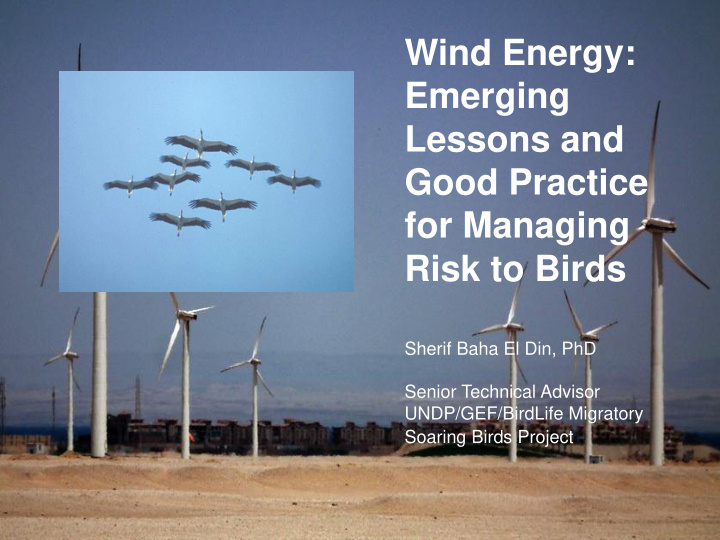



Wind Energy: Emerging Lessons and Good Practice for Managing Risk to Birds Sherif Baha El Din, PhD Senior Technical Advisor UNDP/GEF/BirdLife Migratory Soaring Birds Project
Background Wind is a rapidly growing renewable energy source in Egypt and the region There are strong overlap in some regions between migration flyways and favourable wind energy conditions (e.g. Gulf of Suez)
Risks - Collision with rotor blades and power lines - Displacement: Barrier effect - Habitat loss - Electrocution
Can wind energy and birds co- exist? Wind energy development can occur with relatively limited risk to birds by following a structured approach to the planning, construction and operation of wind farms. Applying the Mitigation Hierarchy: Avoid, Reduce, Mitigate, Offset
Applying the Mitigation Hierarchy Stage Tools Avoid Strategic planning, strategic EIA, sensitivity mapping Reduce EIA, preconstruction monitoring, site planning Mitigate Mitigation measures, post- construction monitoring, adaptive management, shutdown, Offset Variable: To compensate for residual impacts
Strategic Planning Important to apply the strategic approach early on in the planning process Wind energy is a landscape issue that is planned to occupy and affect vast land and sea areas throughout the world (e.g. 9000km² are allotted for wind energy in Egypt) Important to consider power transmission as well. Site specific approaches not satisfactory
Strategic Environmental Assessment (SEA) Balance opportunities and constraints for wind energy development, and identify favoured areas for development. Addressing barrier effects and taking into consideration other existing or planned land uses in the region. Addressing cumulative impacts of multiple wind energy developments may impact upon same species and populations. Should include information on the locations of concentrations and bottlenecks of potentially vulnerable bird species through Sensitivity Mapping.
Sensitivity mapping • Highlights locations where wind energy development would be most critical to birds • Assist planning at early stages • Guides the EIA process • Financial resources are needed to expand and maintain current mapping efforts Example from Gulf of Suez/Red Sea region of Egypt
Partial sensitivity map Gulf of Suez, Egypt Green Zone: clearance for wind energy development subject to EIA Yellow Zone: requires further detailed bird studies Red Zone: considered too sensitive for wind energy development
Environmental Impact Assessment (EIA): Site level Wind energy EIAs must include special assessment of risk to birds This is based on Pre-construction monitoring If positive, the EIA should identify potential mitigation or compensatory options Post-construction monitoring should be integral to the process to confirm pre-construction risk assessment and facilitate adaptive management Technical specs of pre and post-construction monitoring should be standardised to facilitate risk assessment and management across the region
KFW 1,000 MW Study (2010): Conclusions Area divided into 3 zones Zone I covers an area of 53 km ² and encompasses the north-western part of the study area. Collision risk for migrating birds is not expected if mitigation measures to the best standard practice are maintained Zone II has a size of 67 km ² . Given the huge numbers of birds migrating at altitudes below 200 m. Consequently, the expected impact of in Zone II is unacceptable. Construction of wind turbines within Zone II is acceptable only, if an effective shutdown programme is developed Zone III has a size of 88 km ² . Construction of wind farms was strictly banned within
ItalGen Study: Conclusions Most of site not useable NW corner ok as a first phase Second phase possible if post- construction monitoring results are positive in the first phase
Mitigation measures Post-construction Monitoring is important to ensure that mitigation measures are implemented and are effective, with adaptation as necessary Short-term Shutdown during periods of peak bird activity at sites of moderately high risk Minimise attraction of site to birds (prohibit green areas, rubbish tips, water sources in/around site) Leaving corridors between wind farms Smaller number of large turbines (rather than large number of small fast turbines) Avoid turbines with lattice towers (to reduce suitable perching sites) Avoid lighting of turbines, etc.
Shutdown Can be applied only as a mitigation measure where risk level is deemed acceptable but high Can be initiated manually or automatically (radar) once reaching a predetermined thresh- hold: Post-construction Monitoring In response to particular high risk weather conditions (e.g. sand storms, dangerous wind directions)
Offsets After the fulfilment of the Mitigation Hierarchy, if acceptable levels of residual damage are identified, then the conservation or restoration of habitats or removal of threats elsewhere (e.g. hunting) might be undertaken as compensation This is however technically difficult to achieve effectively in many cases, and has considerable uncertainty
Priorities for Bird Risk Management in Egypt Strategic planning and management (large gaps; partly addressed through sensitivity mapping, BLI) Streamlining the EIA process: Unified monitoring and risk assessment guidelines (under development, BLI) Post construction monitoring Unified shutdown guidelines (to be developed) Capacity building (cross cutting issue, needs special attention and investment) Establish data base for monitoring data
Thank you
Recommend
More recommend